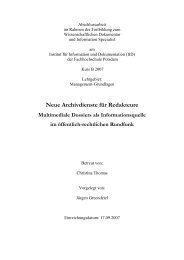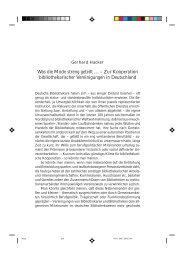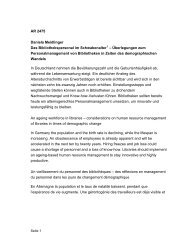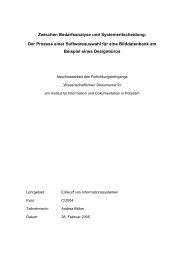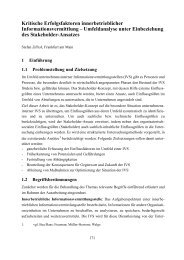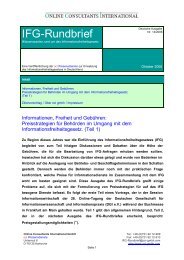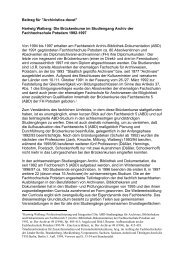PDF(886K) - Wiley Online Library
PDF(886K) - Wiley Online Library
PDF(886K) - Wiley Online Library
You also want an ePaper? Increase the reach of your titles
YUMPU automatically turns print PDFs into web optimized ePapers that Google loves.
Whether a specification of the association relation will lead<br />
to a multitude of semantic relations that are generalizable<br />
(i.e., usable in all or at least most KOS) is an as-yet unsolved<br />
research problem. Certainly, it is clear that we always need<br />
a relation has_property for all concepts of a KOS. This solution<br />
is very general: it would be more appropriate to specify<br />
the kind of property (such as “has melting point” in a KOS<br />
on materials, or “has subsidiary company” in an enterprise<br />
KOS).<br />
A necessary condition for the formulation of a new semantic<br />
relation is that it is significant in a knowledge domain. It is<br />
not wise to use specific, only “private” relations (e.g., resulting<br />
from individual differences in the interpretation of texts;<br />
Morris, 2010) in a KOS, but relations that are common knowledge<br />
to the majority of representatives of the knowledge<br />
domain.<br />
Relations Between Relations<br />
Relations can be in relation to each other (Horrocks &<br />
Sattler, 1999). In the above, we introduced meronymy and<br />
formed structure-disassembling meronymy as its specification,<br />
and within the latter, the component-complex relation,<br />
for example. There is a hierarchy relation between the three<br />
above relations. Such relations between relations can be used<br />
to derive conclusions. If, for example, we introduced to our<br />
concept system:<br />
then it is equally true that<br />
generally formulated:<br />
Roof is a component of house,<br />
roof is a structural part of house and<br />
roof is a part of house,<br />
A is a component of B → A is a structural part of<br />
B → A is a part of B.<br />
Relations and Knowledge Organization Systems<br />
We define KOSs via their cardinality for expressing<br />
concepts and relations. The three “classical” methods in<br />
information science and practice—nomenclature, classification,<br />
thesaurus—are supplemented by folksonomies and<br />
ontologies (Stock & Stock, 2008). Folksonomies represent a<br />
borderline case of KOS, as they do not have a single paradigmatic<br />
relation. Nomenclatures (keyword systems) distinguish<br />
themselves mainly by using the equivalence relation and<br />
ignoring all forms of hierarchical relation. In classification<br />
systems, the (unspecifically designed) hierarchy relation<br />
is added. Thesauri also work with hierarchy; some use<br />
the unspecific hierarchy relation, others differentiate via<br />
hyponymy and (unspecific) meronymy (with the problem [see<br />
Table 1] of not being able to guarantee transitivity). In thesauri,<br />
a generally unspecifically designed association relation<br />
TABLE 1. Reflexivity, symmetry, and transitivity of paradigmatic<br />
relations.<br />
Reflexivity Symmetry Transitivity<br />
Equivalence<br />
– Synonymy R S T<br />
– Gen-Identity −R −S T<br />
– Antonymy<br />
Hierarchy<br />
– Hyponymy<br />
−R S −T<br />
– simple Hyponymy −R −S T<br />
– Taxonomy −R −S T<br />
– Meronymy (unspecific) −R −S ?<br />
– specific Meronymies −R −S T<br />
– Instance<br />
Specific Relations<br />
R −S −T<br />
– “see also” −R S −T<br />
– further Relations Depending on the relation<br />
(“see also”) is necessarily added. Ontologies make use of all<br />
the paradigmatic relations mentioned above (Hovy, 2002).<br />
They are modeled in formal languages, where terminological<br />
logic is also accorded its due consideration. Compared to<br />
other KOS, ontologies categorically contain instances. Most<br />
ontologies work with (precisely defined) further relations.<br />
The fact that ontologies directly represent knowledge (and<br />
not merely the documents containing the knowledge) lets<br />
the syntagmatic relations disappear in this case. If we take<br />
a look at Table 2 or Figure 5, the KOS are arranged from<br />
left to right, according to their expressiveness. Each KOS<br />
can be “enriched” to a certain degree and lifted to a higher<br />
level via relations of the system to its right: A nomenclature<br />
can become a classification, for example, if (apart from<br />
the step from keyword to notation) all concepts are brought<br />
into a hierarchical relation; a thesaurus can become an ontology<br />
if the hierarchy relations are precisely differentiated and<br />
if further specific relations are introduced. An ontology can<br />
become—and now we are taking a step to the left—a method<br />
of indexing if it introduces the syntagmatic relation, i.e., if<br />
it allows its concepts to be allocated to documents, while<br />
retaining all its relations. Thus, the advantages of the ontology,<br />
with its cardinal relation framework, flow together with<br />
the advantages of document indexing and complement each<br />
other.<br />
If there is more than one category in a KOS it is always<br />
possible to construct a faceted KOS (Gnoli, 2008). The categories<br />
mutate into the facets. There are faceted nomenclatures<br />
(Stock & Stock, 2008, pp. 281–284), faceted classification<br />
systems (Broughton, 2006; Gnoli & Mei, 2006; Slavic, 2008;<br />
Vickery, 2008), faceted thesauri (Spiteri, 1999; Tudhope &<br />
Binding, 2008), and even faceted folksonomies (Spiteri,<br />
2010) as well.<br />
On the Way to the Semantic Web?<br />
With ontologies, we have arrived in the core area of<br />
the Semantic Web (Berners-Lee, Hendler, & Lassila, 2001;<br />
1964 JOURNAL OF THE AMERICAN SOCIETY FOR INFORMATION SCIENCE AND TECHNOLOGY—October 2010<br />
DOI: 10.1002/asi



